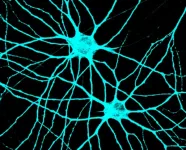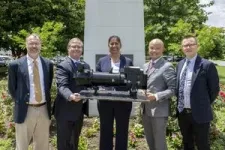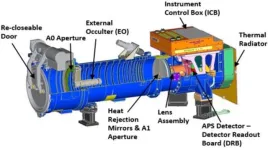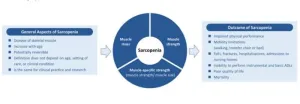(Press-News.org) Newly published research from Colorado State University answers fundamental questions about cellular connectivity in the brain that could be useful in the development of treatments for neurological diseases like autism, epilepsy or schizophrenia.
The work, highlighted in the Proceedings of the National Academy of Sciences, focuses on how neurons in the brain transmit information between each other through highly specialized subcellular structures called synapses. These delicate structures are key to controlling many processes across the nervous system via electrochemical signaling, and pathogenic mutations in the genes that impair their development can cause severe mental disorders. Despite their important role in linking neurons across different brain regions, the way synapses form and function is still not well understood, said Assistant Professor Soham Chanda.
To answer that fundamental question, Chanda and his team in the Department of Biochemistry and Molecular Biology focused on a specific and important type of synapse called GABAergic. He said neuroscience researchers have long hypothesized that these synapses might form because of a release of GABA and the corresponding sensing activity between two neurons in proximity. However, research in the paper now shows that these synapses can begin to develop autonomously and apart from that neuronal communication, mainly due to the scaffolding action of a protein called Gephyrin. These findings clarify the key mechanisms of synaptic formation, which might allow researchers to further focus on synapse dysfunction and health treatment options.
Chanda’s team used human neurons derived from stem cells to develop a model of the brain that could rigorously test these relationships. Using a gene-editing tool called CRISPR-Cas9, they were able to genetically manipulate the system and confirm the role of Gephyrin in the synapse formation process.
“Our study shows that even if a pre-synaptic neuron is not releasing GABA, the post-synaptic neuron can still put together the necessary molecular machineries prepared to sense GABA,” Chanda said. “We used a gene-editing tool to remove the Gephyrin protein from neurons, which largely reduced this autonomous assembly of synapses – confirming its important role irrespective of neuronal communication.”
Using stem cells to advance understanding of neuron and synapse formation
Neuroscientists have traditionally used rodent systems to study these synaptic connections in the brain. While that provides a suitable model, Chanda and his team were interested in testing synapse properties in a human cellular environment that could eventually be more easily translated into treatments.
To achieve this, his team cultivated human stem cells to form brain cells that could mimic the properties of human neurons and synapses. They then conducted extensive high-resolution imaging of these neurons and tracked their electrical activities to understand synaptic mechanisms.
Chanda said that several mutations in the Gephyrin protein have been associated with neurological disorders like epilepsy, which alters neuronal excitability in the human brain. That makes understanding its basic cellular function an important first step towards treatment and prevention.
“Now that we better understand how these synaptic structures interact and organize, the next question will be to elucidate how defects in their relationships can lead to disease and identify the ways one can predict or intervene in that process,” he said.
END
Neuroscience research leverages stem cells to understand how neurons connect and communicate in the brain
Could aid development of treatments for autism, epilepsy or schizophrenia
2024-06-26
ELSE PRESS RELEASES FROM THIS DATE:
NRL CCOR launches on the GOES-U NOAA satellite to monitor space weather
2024-06-26
WASHINGTON – The U.S. Naval Research Laboratory’s (NRL) Compact Coronagraph (CCOR) was launched June 25, on the National Oceanic and Atmospheric Administration (NOAA) Geostationary Operational Environmental Satellite-U (GOES-U) from NASA – Kennedy Space Center to detect and characterize coronal mass ejections (CMEs).
The NOAA sponsored NRL to design, integrate, and test CCOR, a small space telescope that will create an artificial eclipse of the sun and ...
Study shows how liver damage from stress and aging might be reversible
2024-06-26
DURHAM, N.C. – While the liver is one of the body’s most resilient organs, it is still vulnerable to the ravages of stress and aging, leading to disease, severe scarring and failure. A Duke Health research team now might have found a way to turn back time and restore the liver.
In experiments using mice and liver tissue from humans, the researchers identified how the aging process prompts certain liver cells to die off. They were then able to reverse the process in the animals with an investigational drug.
The finding, which ...
Bone stem cells with IFITM5 mutation get caught in a loop leading to osteogenesis imperfecta type V
2024-06-26
A study conducted by researchers at Baylor College of Medicine and collaborating institutions reveals the molecular events leading to osteogenesis imperfecta type V, a form of brittle bone disease caused by a mutation in the gene IFITM5.
The mutation blocks the normal development of bone stem cells into mature cells, which would form healthy bones. Instead, the mutation leads to the formation of bones that are extremely brittle. Children with this disorder have recurrent fractures, bone deformities, chronic pain and other complications. ...
Tai Chi reduces risk of inflammatory disease, treats insomnia among breast cancer survivors
2024-06-26
New research led by UCLA Health confirms that both Tai Chi and cognitive behavioral therapy can reduce insomnia in breast cancer survivors but also may provide additional health benefits by reducing inflammation and bolstering anti-viral defenses.
Chronic insomnia is one of the most prominent symptoms experienced among cancer survivors and poses significant health concerns, including the risk of inflammatory disease that could increase the risk of cancer recurrence.
About 30% of breast cancer survivors are reported to have insomnia, which is twice the rate of the general population. While previous research has shown cognitive behavioral therapy and mind-body ...
Technology presented for measuring carbon in media, advertising and generative AI
2024-06-26
Measuring energy consumption derived from digital activity from a scientific point of view is the challenge faced by Hiili, S.L., a company recently formed and driven by two researchers from the Universidad Carlos III de Madrid (UC3M), Ángel and Rubén Cuevas Rumín, from the Telematics Engineering Department. Specifically, they develop technological solutions that combine Internet measurement techniques and Artificial Intelligence (AI) to make an accurate estimate of the energy consumption of a company's ...
Do people who exercise more have a lower risk of ALS?
2024-06-26
EMBARGOED FOR RELEASE UNTIL 4 P.M. ET, WEDNESDAY, JUNE 26, 2024
MINNEAPOLIS – Moderate levels of physical activity and fitness may be linked to a reduced risk of amyotrophic lateral sclerosis (ALS) later in life, according to a new study published in the June 26, 2024, online issue of Neurology®, the medical journal of the American Academy of Neurology. The study only found an association between physical activity and risk of ALS in male participants, not female participants.
ALS is a rare, progressive neurodegenerative disease that affects nerve cells in the brain and the spinal cord. People with ALS lose the ability to initiate ...
Could preventative drug be effective in people with migraine and rebound headache?
2024-06-26
EMBARGOED FOR RELEASE UNTIL 4 P.M. ET, WEDNESDAY, JUNE 26, 2024
MINNEAPOLIS – A drug used to prevent migraine may also be effective in people with migraine who experience rebound headaches, according to a new study published in the June 26, 2024, online issue of Neurology®, the medical journal of the American Academy of Neurology.
People with chronic migraine who overused pain medication had fewer monthly migraine and headache days and fewer days using pain medication when taking the migraine prevention drug atogepant.
“There is a high prevalence of pain medication ...
Pathologists awarded grant from American Society of Hematology
2024-06-26
Dr. Zhen Mei, a clinical pathologist, and Dr. Vivian Chang, a pediatric hematologist-oncologist, both at UCLA Health, have been awarded $30,000 from the American Society of Hematology to revise blood cell ranges for people with Duffy-null Associated Neutrophil Count, which is also known as Duffy-negative.
Those who are Duffy-negative, estimated to be two out of three people identifying as Black in the U.S., lack Duffy antigens on the surface of their red blood cells as a mechanism to resist malaria. This helps provide protection but ...
Revolutionizing ovarian cancer treatment with adaptive PARP inhibitor therapy
2024-06-26
TAMPA, Fla. — Ovarian cancer, often diagnosed at an advanced stage, presents significant treatment challenges because patients tend to develop resistance to conventional therapies quickly. Despite aggressive treatment, recurrence rates remain high, and managing this disease effectively requires innovative approaches. Poly-adenosine ribose polymerase (PARP) inhibitors have emerged as a treatment option, targeting specific DNA repair mechanisms in cancer cells. However, their use is often limited ...
Global consensus for sarcopenia
2024-06-26
“[...] the development of a global conceptual definition of sarcopenia signifies a new dawn for this muscle disease.”
BUFFALO, NY- June 26, 2024 – A new editorial paper was published in Aging (listed by MEDLINE/PubMed as "Aging (Albany NY)" and "Aging-US" by Web of Science) Volume 16, Issue 11, entitled, “Global consensus for sarcopenia.”
In this new editorial, researchers Ben Kirk, Peggy M. Cawthon, and Alfonso J. Cruz-Jentoft from the University of Melbourne and Western Health discuss the global societal issue of skeletal muscle loss and weakness, termed Sarcopenia. Low muscle ...
LAST 30 PRESS RELEASES:
Application of orthogonal CNOP-I in a convection-allowing ensemble prediction system based on CMA-MESO for improving extreme precipitation skill
Study suggests bamboo has ‘superfood’ potential
Hidden heart-care gaps among Asian American patients
Blood test predicts which patients with lung cancer will benefit from newly approved immunotherapy drug
SwRI’s Dr. Michael Davis named SPIE Fellow
Exposure to “forever chemicals” linked to higher risk of gestational diabetes, major review finds
Insilico Medicine integrates Nach01 Foundation Model with Microsoft Discovery to enable AI-native, enterprise-ready drug discovery workflows
New study reveals precursors for forecasting summer clustered extreme precipitation events in Northeast China
A bacterial toxin can counteract colorectal cancer growth
Frozen hydrogen cyanide ‘cobwebs’ offer clues to origin of life
Physics of foam strangely resembles AI training
Bis-pseudoindoxyls: a new class of single benzene-based fluorophores for bioimaging applications
Blocking a cancer-related pathway helps reduce spine deformities due to genetic disorder, finds new study
New study explores therapeutic potential of CRISPRCas3 genome-editing system
Korea University researchers revive an abandoned depression drug target using structurally novel NK1 receptor inhibitors
Jeonbuk National University researchers highlight advancements in chemical looping fluidized bed reactors
Tyrannosaurus rex grew up slowly: New study reveals the “king of dinosaurs” kept growing until age 40
Commercial water dispenser machines may contain more contamination than tap water
Death and doctors: New WSU study looks at medical student education on end-of-life care
The best hydrogen for heavy-duty transport is locally produced and green
Pregnancy-related high blood pressure varied among Asian, Pacific Islander subgroups
Measuring movement creates new way to map indoor air pollution
Europe’s crop droughts to get worse even as rain increases
New study identifies signature in blood to better predict type 2 diabetes risk
Research spotlight: developing “smart” nanoparticles to deliver targeted gene therapy in osteoarthritis
A CRISPR fingerprint of pathogenic C. auris fungi
Time warp: How marketers express time can affect what consumers buy
CBD treatment reverses key effects of fetal alcohol spectrum disorder in a mouse model
Blood sugar spikes linked to higher risk of Alzheimer's disease
Staying single for longer affects young people’s well-being
[Press-News.org] Neuroscience research leverages stem cells to understand how neurons connect and communicate in the brainCould aid development of treatments for autism, epilepsy or schizophrenia



